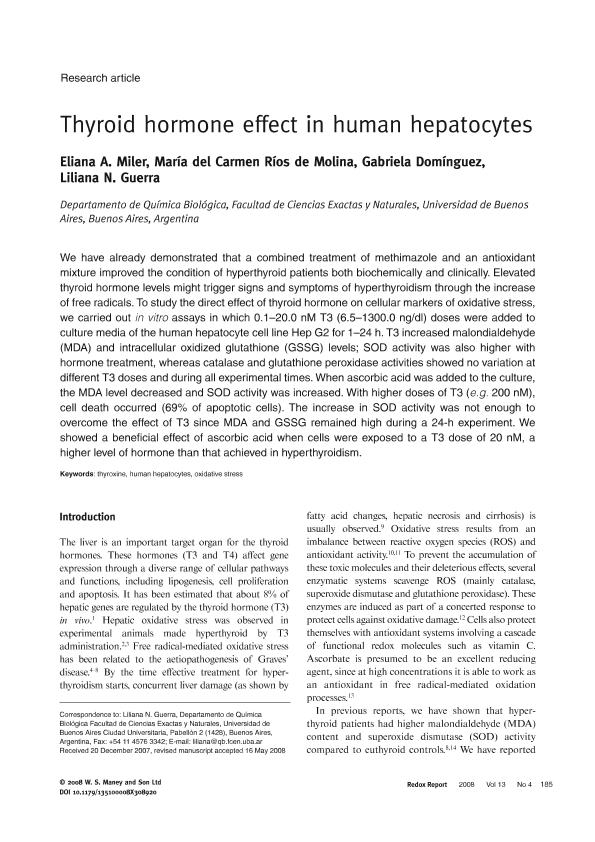Mostrar el registro sencillo del ítem
dc.contributor.author
Miler, Eliana Andrea

dc.contributor.author
Rios, Maria del Carmen

dc.contributor.author
Dominguez, Gabriela

dc.contributor.author
Guerra, Liliana Noemi

dc.date.available
2019-09-24T22:08:19Z
dc.date.issued
2008-12
dc.identifier.citation
Miler, Eliana Andrea; Rios, Maria del Carmen; Dominguez, Gabriela; Guerra, Liliana Noemi; Thyroid hormone effect in human hepatocytes; Taylor & Francis; Redox Report; 13; 4; 12-2008; 185-191
dc.identifier.issn
1351-0002
dc.identifier.uri
http://hdl.handle.net/11336/84371
dc.description.abstract
We have already demonstrated that a combined treatment of methimazole and an antioxidant mixture improved the condition of hyperthyroid patients both biochemically and clinically. Elevated thyroid hormone levels might trigger signs and symptoms of hyperthyroidism through the increase of free radicals. To study the direct effect of thyroid hormone on cellular markers of oxidative stress, we carried out in vitro assays in which 0.1-20.0 nM T3 (6.5-1300.0 ng/dl) doses were added to culture media of the human hepatocyte cell line Hep G2 for 1-24 h. T3 increased malondialdehyde (MDA) and intracellular oxidized glutathione (GSSG) levels; SOD activity was also higher with hormone treatment, whereas catalase and glutathione peroxidase activities showed no variation at different T3 doses and during all experimental times. When ascorbic acid was added to the culture, the MDA level decreased and SOD activity was increased. With higher doses of T3 (e.g. 200 nM), cell death occurred (69% of apoptotic cells). The increase in SOD activity was not enough to overcome the effect of T3 since MDA and GSSG remained high during a 24-h experiment. We showed a beneficial effect of ascorbic acid when cells were exposed to a T3 dose of 20 nM, a higher level of hormone than that achieved in hyperthyroidism.
dc.format
application/pdf
dc.language.iso
eng
dc.publisher
Taylor & Francis

dc.rights
info:eu-repo/semantics/openAccess
dc.rights.uri
https://creativecommons.org/licenses/by-nc/2.5/ar/
dc.subject
Human Hepatocytes
dc.subject
Oxidative Stress
dc.subject
Thyroxine
dc.subject.classification
Bioquímica y Biología Molecular

dc.subject.classification
Medicina Básica

dc.subject.classification
CIENCIAS MÉDICAS Y DE LA SALUD

dc.title
Thyroid hormone effect in human hepatocytes
dc.type
info:eu-repo/semantics/article
dc.type
info:ar-repo/semantics/artículo
dc.type
info:eu-repo/semantics/publishedVersion
dc.date.updated
2019-02-12T17:09:48Z
dc.journal.volume
13
dc.journal.number
4
dc.journal.pagination
185-191
dc.journal.pais
Reino Unido

dc.journal.ciudad
Londres
dc.description.fil
Fil: Miler, Eliana Andrea. Consejo Nacional de Investigaciones Científicas y Técnicas; Argentina. Universidad de Buenos Aires. Facultad de Ciencias Exactas y Naturales. Departamento de Química Biológica; Argentina
dc.description.fil
Fil: Rios, Maria del Carmen. Consejo Nacional de Investigaciones Científicas y Técnicas; Argentina. Universidad de Buenos Aires. Facultad de Ciencias Exactas y Naturales. Departamento de Química Biológica; Argentina
dc.description.fil
Fil: Dominguez, Gabriela. Universidad de Buenos Aires. Facultad de Ciencias Exactas y Naturales. Departamento de Química Biológica; Argentina
dc.description.fil
Fil: Guerra, Liliana Noemi. Consejo Nacional de Investigaciones Científicas y Técnicas; Argentina. Universidad de Buenos Aires. Facultad de Ciencias Exactas y Naturales. Departamento de Química Biológica; Argentina
dc.journal.title
Redox Report

dc.relation.alternativeid
info:eu-repo/semantics/altIdentifier/doi/http://dx.doi.org/10.1179/135100008X308920
dc.relation.alternativeid
info:eu-repo/semantics/altIdentifier/url/https://www.tandfonline.com/doi/abs/10.1179/135100008X308920
Archivos asociados
